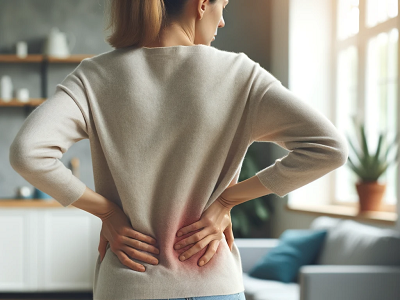Lower Back Pain? It Could Be Pelvic Inflammatory Disease!
Low back pain is an early warning of many diseases for women. Therefore, women should be extremely careful not to let gynecological diseases take advantage of their momentary carelessness. Pelvic inflammatory disease is one of the most common gynecological diseases, and it may lead to lower back pain symptoms in female patients.

Pelvic inflammatory disease is an inflammatory condition caused by inflammatory changes in the pelvic visceral organs, such as congestion, edema, and adhesions. It usually reflects on the body's surface and manifests as visceral pain. Pelvic inflammatory disease is divided into chronic and acute; acute pelvic inflammatory disease manifests as fever and abdominal pain, and the pain is usually more intense.
In contrast, chronic one can cause lumbosacral pain, which is due to the adhesions, scarring, and pelvic congestion formed by the inflammation, usually causing lower abdominal pain and lumbosacral pain. It is often aggravated by exertion, after sexual intercourse, and around the time of menstruation.
In addition, because patients have more severe pelvic congestion, many people experience very severe lower back pain along with abdominal pain. Some people have unbearable lower back pain, while others experience mild lumbosacral soreness, aching, or pain.
Many women will mistake the back pain caused by pelvic inflammatory disease for lumbar muscle strain or problems with the lumbar spine. Therefore, after the appearance of back pain, the first thing they did was to go to the orthopedic department to seek medical treatment. If the lumbar spine has problems after examination, the treatment will be stuck on the lumbar spine problem, thus delaying the treatment of chronic pelvic inflammatory disease.
Therefore, if female patients experience symptoms of lower back pain, they must be alert to PID. They should take timely treatment to relieve the pain. After the inflammation improves, the painful symptoms gradually reduce until they disappear.
So, how do you relieve the pain caused by pelvic inflammatory disease?
Generally, it can be treated by conservative treatment, strengthening exercise, physical therapy, traditional Chinese medicine, etc. Patients should take corresponding treatment measures according to different causes.
1. Conservative Treatment: Pelvic inflammatory disease is a common gynecological condition. As the infection progresses, it leads to an increased secretion of pelvic tissue fluid, which can accumulate in the lumbosacral region and cause lower back pain symptoms. Patients can receive treatment under a doctor's guidance using medications such as levofloxacin hydrochloride and metronidazole tablets. During the treatment, it is important to avoid sexual activity to prevent cross-infection.
2. Strengthening Exercise: Patients should participate in outdoor sports to strengthen exercise, which can prevent the recurrence of the disease and also effectively help to improve the body's immune function.
3. Physical Therapy: Patients with particularly severe lower back pain can take methods such as electric heat treatment or infrared therapy to improve local blood circulation, which can help relieve the symptoms of lower back pain.
4. Traditional Chinese Medicine (TCM) Treatment: Patients can take Fuyan Pill orally under the guidance of a doctor for treatment and, at the same time, take a rest. Fuyan Pill is composed of over 50 kinds of pure natural herbs. It has the effects of clearing heat, detoxification, promoting blood circulation, and removing stasis. It can gradually alleviate the pain and other symptoms, and it won't have any adverse effects on the body.
In addition, if the back pain is caused by chronic pelvic inflammatory disease, it is often accompanied by menstrual and leukorrhea abnormalities. Therefore, women with frequent back pain should pay attention to whether their menstruation and leukorrhea are normal. Especially for leukorrhea, patients can observe the quantity, quality, color, and smell.
Generally speaking, the presence of leukorrhea in large amounts, yellowish and thick, with a foul smell, etc., indicates that pelvic inflammatory disease is more serious. At this time, women should go to the gynecologist in time to avoid aggravation of the condition.
To summarize, patients with lower abdominal discomfort, such as lower back pain and lower abdominal distension, are advised to seek early medical treatment to avoid delaying their condition. Acute pelvic inflammatory disease sometimes will cause recurrent symptoms after it becomes chronic, and even some patients with fertility requirements will have infertility symptoms, so it is recommended to consult a doctor as soon as possible.
You may also be interested in:
Will Pelvic Inflammatory Disease Cause Constipation?
How to Prevent Acute Episodes of Chronic Pelvic Inflammatory Disease(PID)?
Will Pelvic Inflammatory Disease Cause Constipation?
previous pageCan Pelvic Inflammatory Disease Cause Frequent Urination?
next page- Severe Endometriosis Treatment: Chronic Pelvic Pain Relief and Infertility Solutions
- Managing Adenomyosis: Easing Pelvic Pain and Heavy Menstrual Bleeding with Natural Approaches
- Daily Care Tips for Pelvic Inflammatory Disease Caused by Ureaplasma Urealyticum
- Is Fallopian Tube Blockage Causing Your Lower Abdominal Pain?
- Don't Let Pelvic Pain Trouble You! Traditional Chinese Medicine and Dietary Therapy to the Rescue
Testimonials
- Adenomyosis with Ureaplasma Urealyticum Cured by Fuyan Pill
- Tubal blockage with hydrosalpinx can be cured by TCM shortly
- Fuyan Pill Helps A woman with Adenomyosis Get Pregnant
- A Woman with Hydrosalpinx Is Cured with Fuyan pill
- Pelvic Inflammatory Disease Testimonials
- Irregular Vaginal Bleeding and Endometrial Thickening Cured by Fuyan Pill
- Pruritus Vulvae and Frequent Urination: Mycoplasma Infection Cured after 2 Courses



